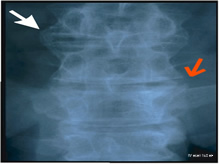U.C.L.A. Rheumatology Pathophysiology of Disease Course Lecture,
Second Year Medical School 1997
Ankylosing Spondylitis Page 20
Early in AS chest expansion is reduced since the ligaments attaching the ribs to both the vertebrae and the sternum become inflamed. The muscles around the shoulder and hip girdles become very tight. Sometimes the shoulder and hip capsules become inflamed. This causes pain and restricted motion. The synovium may become inflamed but it is not a primary target as in RA. Heel pain may be a prominent feature; this is caused by an enthesopathy (inflammation of the enthesis) because the site of inflammation is where the Achilles tendon and the plantar fascia attach to the calcaneus (figure 4).
AS tends to affect principally the axial skeleton, with stiffness and restricted motion in the spine. Peripheral joints are only affected in 25% of patients. The eye may become inflamed acutely because of an iritis. Long-standing AS is associated with dilatation of the aortic root and scarring of the aortic valve cusps, resulting in aortic insufficiency. An unusual scarring of the apex of the lungs
